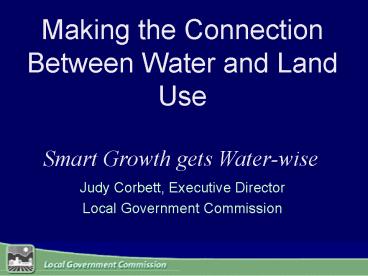Making the Connection Between Water and Land Use PowerPoint PPT Presentation
1 / 52
Title: Making the Connection Between Water and Land Use
1
Making the Connection Between Water and Land Use
Smart Growth gets Water-wise
- Judy Corbett, Executive Director
- Local Government Commission
2
Why Should City and County Officials Be
Concerned About Water?
3
Water and the Local Economy
4
New Water Quality Regulations
5
Flood Risks
6
Where do our precious water resources come
from?
7
Healthy Watersheds
A watershed is the area of land that drains into
a river, lake, or estuary and/or flows into the
groundwater basin.
8
All land, developed or not, is in a watershed.
9
The biggest influence on future water supplies
and quality in California is local land use
planning.Celeste Cantu, Executive Director
California State Water Resources Control Board
10
Where and How We Grow are Key
11
DONT grow in important natural areas in the
watershed.
When more that 40 of a watershed is covered in
pavement, the costs of making water fit to drink
with a water treatment system increases by a
factor of 5.
12
(No Transcript)
13
We have been growing to accommodate the car
14
U.S. Population Growth and Transportation
1970-1996
15
(No Transcript)
16
(No Transcript)
17
(No Transcript)
18
(No Transcript)
19
Without realizing the consequences, we have
been covering over watersheds at a rapid rate!
20
Development Patterns in the San Francisco Bay
region 1850Green Wetlands Red Urban Area
21
Development Patterns in the San Francisco Bay
region 1900Green Wetlands Red Urban Area
22
Development Patterns in the San Francisco Bay
region 1950Green Wetlands Red Urban Area
23
Development Patterns in the San Francisco Bay
region 1990Green Wetlands Red Urban Area
24
According to the US EPA, sprawl is one of the
greatest threats to our water resources.
25
We need to grow in ways that pave less land.
To reduce flood risks, ensure clean and reliable
water supplies, and comply with permits and
regulations
26
How We Should Grow
Growing in the form of compact walkable
communities takes up less land, reduces the
amount of impervious surfaces.
27
(No Transcript)
28
Downtown instead of a mall
29
Narrow streets instead of wide ones
30
Parking structures instead of large surface lots
31
Mixed use instead of single use
32
Walking transit instead of car
33
Sprawling large lot residential versus townhouses
or small lot houses
34
How to fix what we have
35
How to fix what we have
36
How to fix what we have
Photo Simulation by Steve Price, Urban Advantage
(www.urban-advantage.com)
37
Getting Water-wiseon a Site Level
38
Daylight creeks and restore wetlands
39
Direct runoff from pavement and buildings to
permeable surfaces.
40
Use Permeable Materials for Paving
41
Design parks and recreation areas to hold excess
runoff
42
Plant and protect trees - they reduce runoff and
encourage infiltration.
43
Getting Water-wisein Homes, Businesses,and
Public Buildings
44
Implement water conservation by making efficient
water use a goal in local land use.
- Every time water is wasted, money and a precious
resource go down the drain. - California Department of Water Resources
45
Credit goes to programs that have encouraged
the use of conservation technologies -such as
low flow toilets- in homes and businesses.
Despite significant population growth,
residential water use for the city of Los Angeles
is the same today as it was 30 years ago.
46
Water recycling and reuse are widely utilized as
cost-effective and reliable sources of water for
many appropriate uses.
In California alone, communities are using
recycled water at over 4,800 sites.
47
The Ahwahnee Water Principles
- An integrated set of nine community planning
principles and five implementation measures that
address water in land use. - Developed by the Local Government Commission
with leading experts in water resources, land
use, and community design. - Address concerns about storm water runoff, flood
risks, efficient use, and the reliability of
local water supplies. - Cost-saving planning and design guidelines that
can be implemented by cities and counties to
protect water resources.
48
Fact Sheets
- Five illustrated fact sheets addressing critical
links between - local land use and the sustainability of water
resources. - They provide solutions to critical water resource
issues and - include case studies, policy language, and
additional - resources.
1) Land Use and Watersheds 2) Livable Communities
and Water 3) Water Conservation 4) Water
Recycling and Reuse 5) Urban Stormwater Management
49
(No Transcript)
50
First Stop Shop for Water Resources
- The newest of the Local Government Commissions
- award winning websites.
- Puts the most relevant, up-to-date, and useful
information - in one place. The site is easy to navigate so
you can find - what you need fast.
- Go to water.lgc.org
51
Your community will enjoyA clean and
sustainable water supply Reduced
floodingHealthier watershedsReduced runoff and
water pollutionAnd no penalties from the EPA!
The Ahwahnee Water Principles -Put them in your
General Plan!
52
For more information and resources
- Web water.lgc.org
- Phone 800-290-8202
- e-mail center_at_lgc.org

